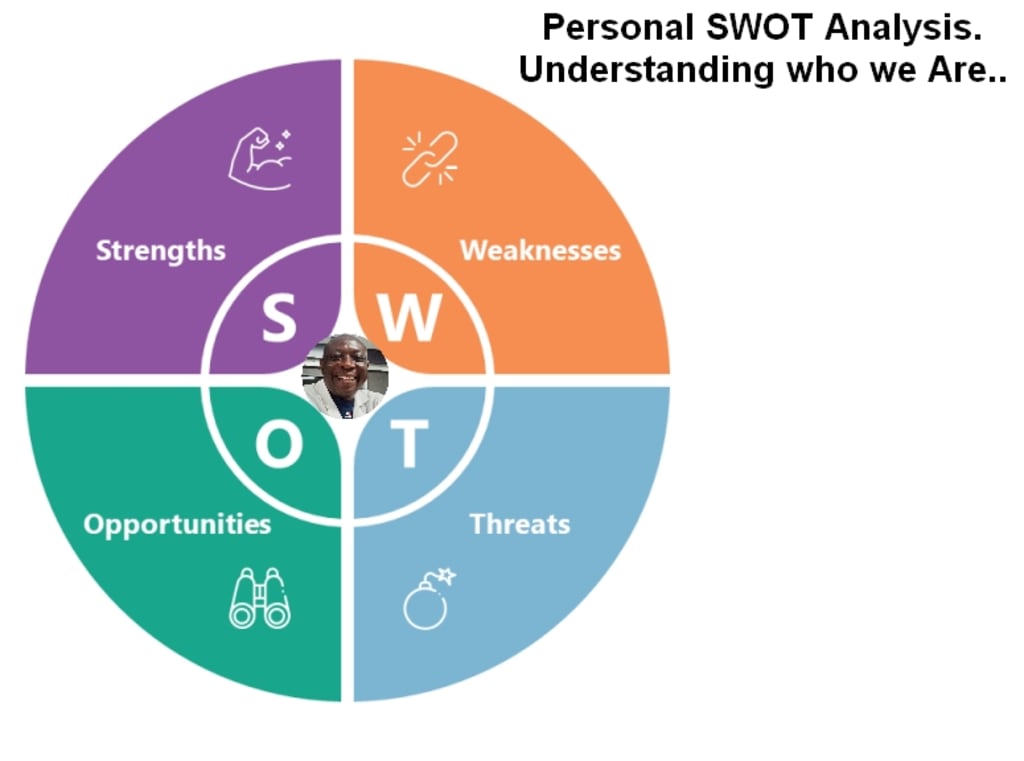
Conducting a Personal SWOT Analysis.
Unveiling Personal Strengths, Weaknesses, Opportunities, and Threats
Introduction:
How can individuals conduct a personal SWOT analysis effectively?
Welcome to today's episode of "Personal Development Strategies." In this session, we will explore the concept of conducting a personal SWOT analysis. A SWOT analysis is a powerful tool that can help individuals gain insight into their strengths, weaknesses, opportunities, and threats.
What is a personal SWOT analysis and why it is beneficial for individuals.
A personal SWOT analysis is a self-assessment technique that allows individuals to evaluate their internal strengths and weaknesses, as well as external opportunities and threats. By identifying these factors, individuals can gain a deeper understanding of themselves and make informed decisions regarding their personal and professional lives.
Step-by-step guide to conducting a personal SWOT analysis:
Step 1: Identify Your Strengths
• Reflect on your personal qualities, skills, and knowledge.
• Ask yourself: What am I good at? What unique abilities do I possess?
• Consider feedback from others and acknowledge your accomplishments.
Step 2: Recognize Your Weaknesses
• Assess areas where you struggle or need improvement.
• Ask yourself: What skills or knowledge do I lack? What areas do I find challenging?
• Be honest with yourself and identify areas for personal growth.
Step 3: Explore Opportunities
• Examine external factors that could present opportunities for personal development or advancement.
• Ask yourself: What new trends or technologies can I leverage? Are there any emerging markets or career paths?
• Stay informed about industry developments and be open to new possibilities.
Step 4: Identify Threats
• Consider external factors that may hinder your personal growth or pose challenges.
• Ask yourself: What are the potential obstacles or competition I might face? Are there any economic or societal factors that could impact me negatively?
• Anticipate potential risks and challenges to be better prepared.
Step 5: Analyze and Prioritize
• Review your strengths, weaknesses, opportunities, and threats together.
• Look for connections and patterns between them.
• Prioritize based on their impact and importance to your personal and professional goals.
Step 6: Develop Action Plans
• Create actionable steps to leverage your strengths and pursue opportunities.
• Devise strategies to overcome weaknesses and minimize threats.
• Set realistic goals and establish timelines to track progress.
Step 7: Seek Feedback and Support
• Share your SWOT analysis with trusted mentors, colleagues, or friends.
• Seek their insights and perspectives on your self-assessment.
• Embrace constructive feedback and utilize their support in achieving your goals.
These are excellent guidelines, of how an individual might apply a personal SWOT analysis in their career
Let's consider an individual working in the marketing industry. Through a personal SWOT analysis, they may discover their strengths lie in their creativity, strong communication skills, and ability to analyze data. However, they may also identify a weakness in public speaking and a lack of experience in emerging social media platforms. By recognizing these weaknesses, they can seek training or professional development opportunities to address them. Furthermore, the analysis may reveal opportunities in digital marketing trends or specialization, while threats may include stiff competition
There are several advantages to conducting a personal SWOT analysis.
1. Self-Awareness: A personal SWOT analysis promotes self-awareness by encouraging individuals to reflect on their strengths, weaknesses, opportunities, and threats. It helps individuals gain a deeper understanding of their capabilities, areas for improvement, and the external factors that may impact their personal and professional lives.
2. Capitalizing on Strengths: By identifying and understanding their strengths, individuals can leverage them to their advantage. They can focus on utilizing their unique abilities and qualities to excel in their chosen field or pursue new opportunities aligned with their strengths.
3. Addressing Weaknesses: A SWOT analysis brings attention to areas of weakness or areas that require improvement. It provides individuals with an opportunity to develop strategies to overcome these weaknesses through training, education, or seeking support from mentors or colleagues.
4. Identifying Opportunities: Conducting a personal SWOT analysis helps individuals recognize external opportunities that align with their strengths and interests. It allows them to explore new avenues, embrace emerging trends, and take advantage of potential growth areas in their personal and professional lives.
5. Anticipating Threats: By considering potential threats, individuals can proactively prepare for challenges they may encounter. They can develop contingency plans, stay updated on industry changes, and make informed decisions to mitigate potential risks.
6. Setting Goals and Priorities: A SWOT analysis provides a foundation for setting goals and establishing priorities. It helps individuals align their objectives with their strengths and opportunities, while also addressing weaknesses and minimizing threats. This focus allows individuals to direct their efforts toward meaningful and achievable targets.
7. Strategic Decision Making: A personal SWOT analysis equips individuals with valuable insights for making strategic decisions. It helps them evaluate options, weigh potential outcomes, and choose the most advantageous path based on their strengths, weaknesses, opportunities, and threats.
8. Enhanced Self-Confidence: Understanding one's strengths and opportunities can boost self-confidence. When individuals recognize their capabilities and align them with their goals, they gain a sense of empowerment and belief in their ability to succeed.
9. Personal Development and Growth: The process of conducting a personal SWOT analysis encourages continuous personal development and growth. By addressing weaknesses, seeking opportunities, and adapting to changing circumstances, individuals can evolve and enhance their skills, knowledge, and overall potential.
10. Accountability and Measurement: A SWOT analysis provides a framework for accountability and measurement of progress. Individuals can track their achievements, monitor their efforts in addressing weaknesses, and evaluate the impact of their strategies over time.
Conclusion.
Conducting a personal SWOT analysis offers numerous advantages, including increased self-awareness, capitalizing on strengths, addressing weaknesses, identifying opportunities, anticipating threats, setting goals, making strategic decisions, boosting self-confidence, fostering personal development, and providing a basis for accountability and measurement. It serves as a valuable tool for individuals seeking personal and professional growth.





Comments (1)
https://vocal.media/motivation/conducting-a-personal-swot-analysis